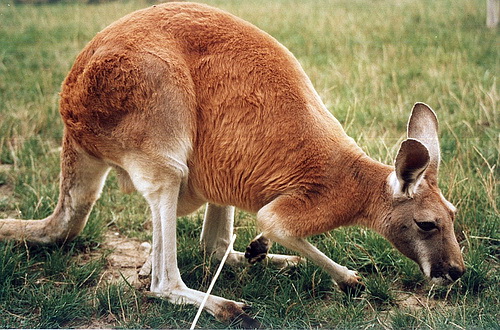Red Kangaroo (Macropus rufus) - Wiki Red Kangaroo
From Wikipedia, the free encyclopedia
[Photo] Red Kangaroo (Macropus rufus). Photo by Drs.
The Red Kangaroo (Macropus rufus) is the largest of all kangaroos and the largest surviving marsupial. It is found across mainland Australia, avoiding only the more fertile areas in the south, the east coast, and the northern rainforests.
Description
This species is a very large kangaroo with short, red-brown fur, fading to pale buff below and on the limbs. It has long, pointed earlobes and a squared-off muzzle. Females are smaller than males and are blue-grey with a brown tinge, pale grey below, although arid zone females are coloured more like males. It has two appendages with small claws (much like arms), two muscular legs, which are used for jumping, and a tail, which is often used like a third leg for balance.
Red Kangaroo's legs work much like a rubber band. The male Red Kangaroo can leap in full force approximately 30 feet (9.14 meters) in one leap.
Males grows up to 1.8m (6ft) tall and weigh up to 85 kg (187lbs). Females grow up to 1.1m (3.6ft) tall and weigh up to 35kg (77lbs). Tails can be up to 1m (3ft) along.
Ecology
The Red Kangaroo inhabits most of the dry inland of the central part of Australia in small groups called mobs. It prefers open plains where trees and bushes are scarce.
Red Kangaroos maintain their internal temperatures at a point of homeostasis (about 36°C) using a variety of physical, physiological and behavioural adaptations. These include having an insulating layer of fur, being less active and staying in the shade when temperatures are high, panting, sweating, and licking its forelimbs.
The Red Kangaroo is nocturnal and crepuscular, and largely spends the daylight hours sleeping or otherwise relaxing.
Feeding
The Red Kangaroo prefers to eat grasses and other vegetation. It can go long periods of time without water, as long as it has access to green plants as they have the ability to take moisture out of plants.
Vision
The Red Kangaroo's range of vision is approximately 300 degrees due to the position of their eyes. A human's range of vision is around 180 degrees in comparison.
Fighting
When male kangaroos fight, they may appear to be 'boxing'. They usually stand up on their hind limbs and attempt to push their opponent off balance by jabbing him or locking forearms. If the fight escalates, they will begin to kick each other. Using their tail to support their weight, they deliver kicks with their powerful hind legs.
http://en.wikipedia.org/wiki/Red_Kangaroo
| The text in this page is based on the copyrighted Wikipedia article shown in above URL. It is used under the GNU Free Documentation License. You may redistribute it, verbatim or modified, providing that you comply with the terms of the GFDL. |
